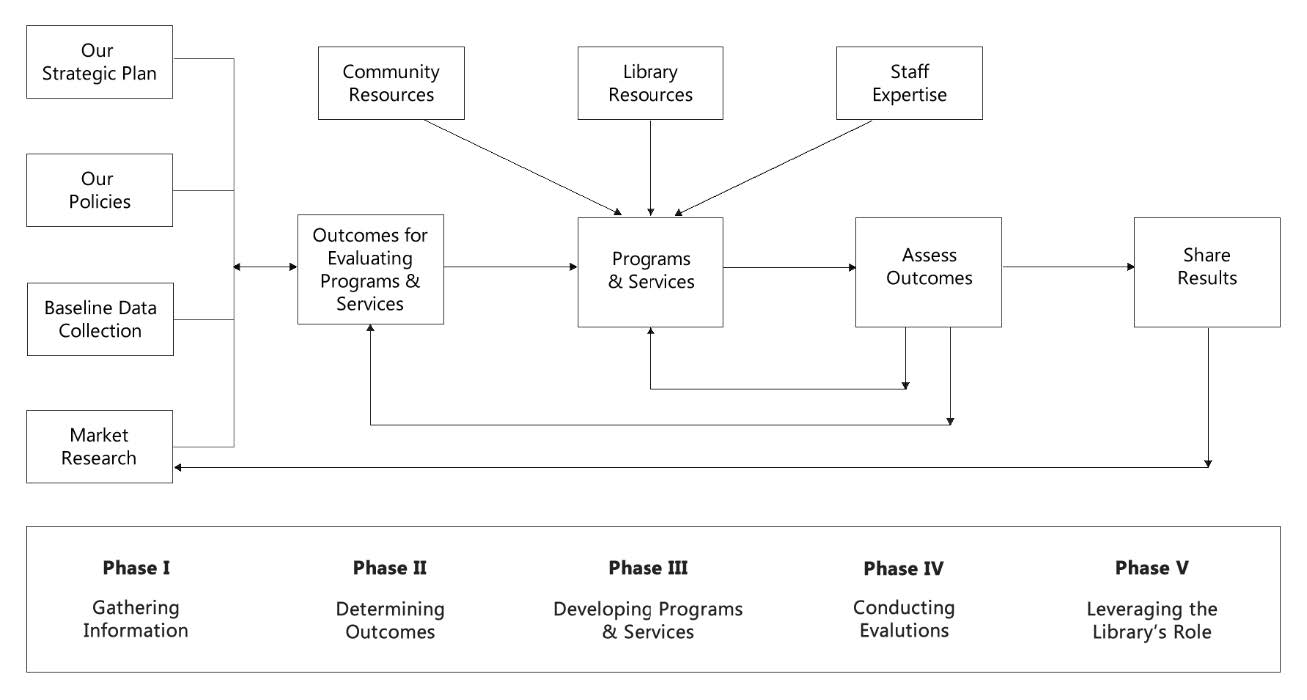Outcome-Based Planning & Evaluation
The Outcome-Based Planning and Evaluation (OBPE) approach is a data-driven way to create, implement, and evaluate library programs and services based on community need.
What is OBPE?
OBPE is a library-industry standard providing a systematic way to plan and evaluate user-centered services and programs. It’s also a process in which library services and programs are intentionally designed to impact people in specific ways. Impacts are defined as outcomes that will improve the lives of library customers by helping them obtain desired skills or knowledge, attitudes or behaviors, or make improvements in their condition or status.
OBPE Phases
OBPE consists of five phases ranging from gathering information to leveraging the library’s role in the community.
Phase I – Gather Information
To understand the needs of Oklahoma County residents, library staff gathered information to develop a Community Needs Assessment for Oklahoma County. The needs assessment framework outlined categories ranging from demographics to transportation. The key findings from this 87-page document led to the creation of six overarching categories (Literacy, Educational Attainment, Workforce Development, Health and Wellness, Cultural Enrichment, and Civic Engagement) the library will use to develop programs and services.
Phase II – Define Outcomes
Using the six categories discovered in Phase I, staff crafted outcome statements. The outcome statements went through several iterations and review. The finalized outcome statements now serve as the paramount goal for each of the six categories and will serve as a foundation for any programs and services related to that outcome.
Outcome Statements
| Literacy | Residents belong to a community of readers and understand literacy is fundamental to their future. |
| Educational Attainment | Residents reach their educational goals and recognize the importance of lifelong learning. |
| Workforce Development | Residents gain the knowledge and skills needed to attain their highest level of desired employment. |
| Health and Wellness | Residents make informed choices about their health and overall well-being. |
| Cultural Enrichment | Residents value arts and culture and find meaning in the experiences. |
| Civic Engagement | Residents build community through civic dialogue and action. |
Phase III – Develop Services & Programs
After finalizing the outcome statements, members from the Adult, Children & Teen Cabinets were asked to select which outcome workgroup they would like to participate in. Staff had an opportunity to rank their preferences. From there, six workgroups were formed to research, plan, and prepare recommendations for achieving the identified outcomes. EPS staff members serve as the chair and co-chair of each of the workgroups.
Phase IV – Conduct Evaluations
Evaluation of success is paramount. Outcome evaluation measures the impact on, benefits to, and positive changes experienced by community members as a result of participating in the library’s services or programs. Evaluation provides an evidence-based means of communicating achievement to people inside and outside the library. In planning future programs and services, identifying the means to determine success is conducted in the beginning, as a part of the planning process. As project teams form and begin to create and plan individual programs and services on the tactical level, they will want to design an evaluation strategy, making sure to keep the following questions in mind:
- What information is needed to evaluate the success of the program or service?
- Which data collection methods will yield the most useful findings?
- Will program participants be willing and able to participate in the evaluation process?
- What would indicate success?
- How can success be measured?
- What is the target the library is set to achieve?
Phase V – Leverage the Library
After steps are complete, the library will use success stories to leverage our role. These narratives can be used to create support for future initiatives and effectively share our impact. Our target audiences could include: funders, partners, library administrators, library commission, elected officials, library staff and customers, community organizations, other libraries and library systems, local media and social media.
| Download Community Needs Assessment | Download Engagement Proposal |

